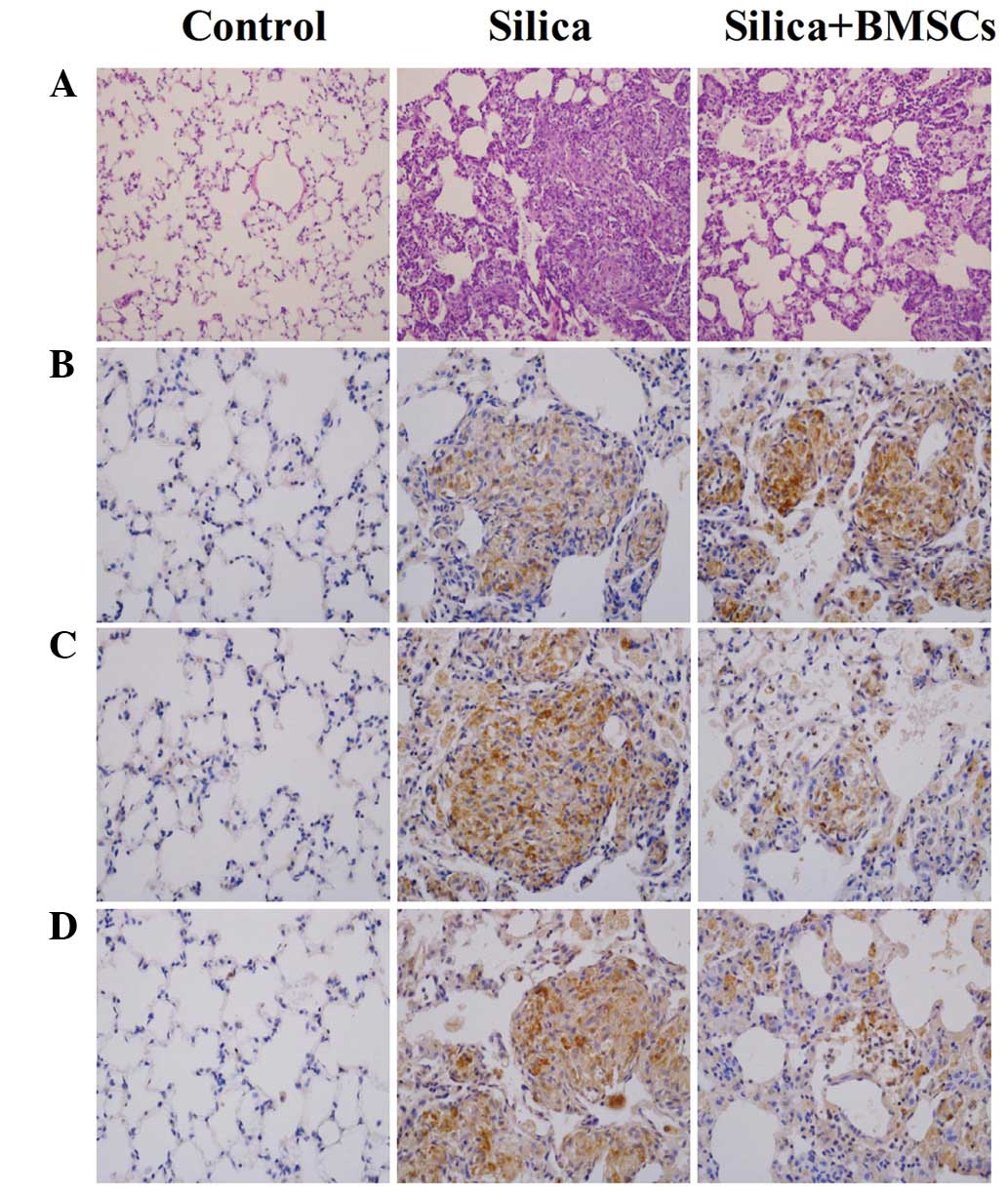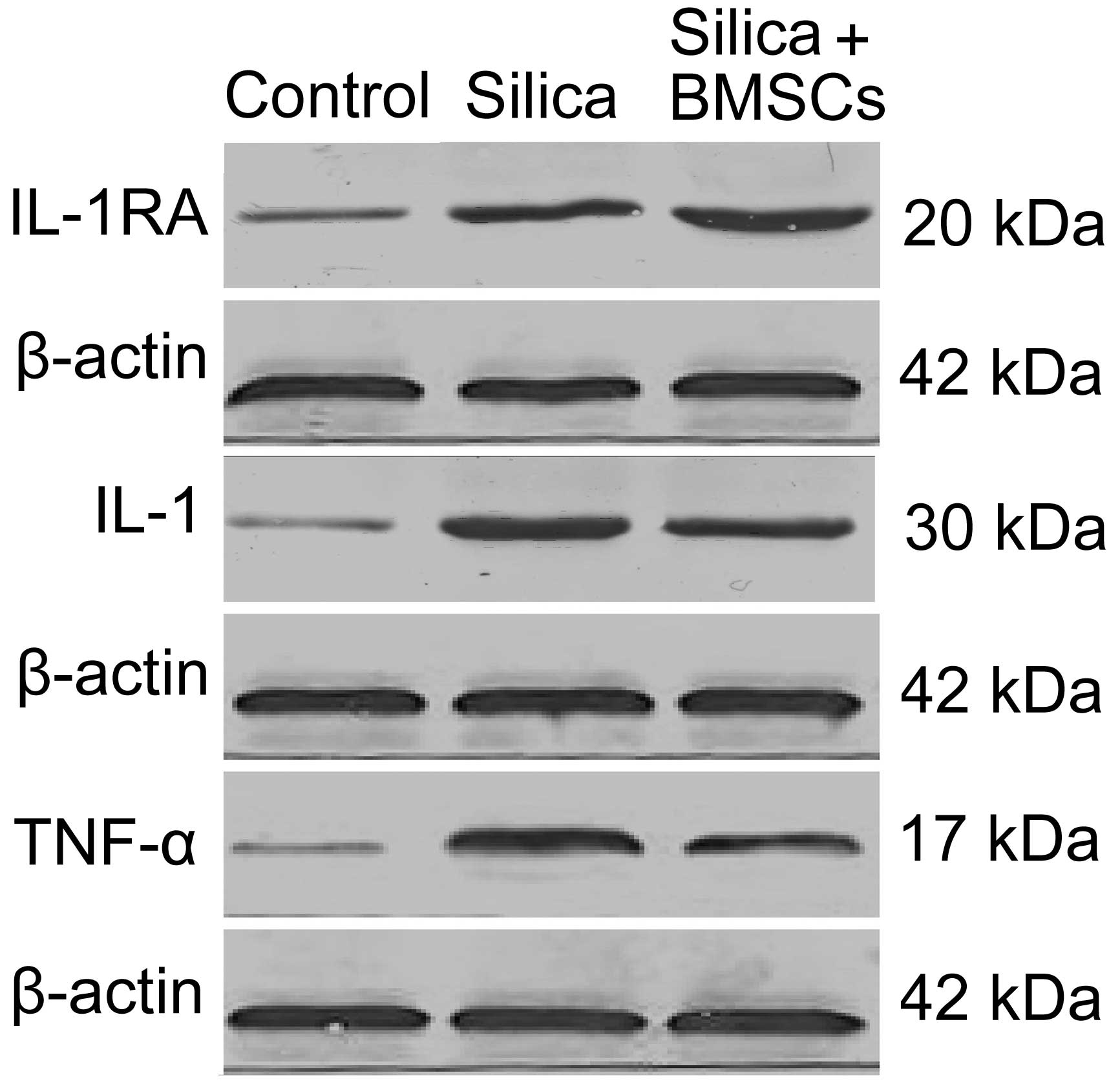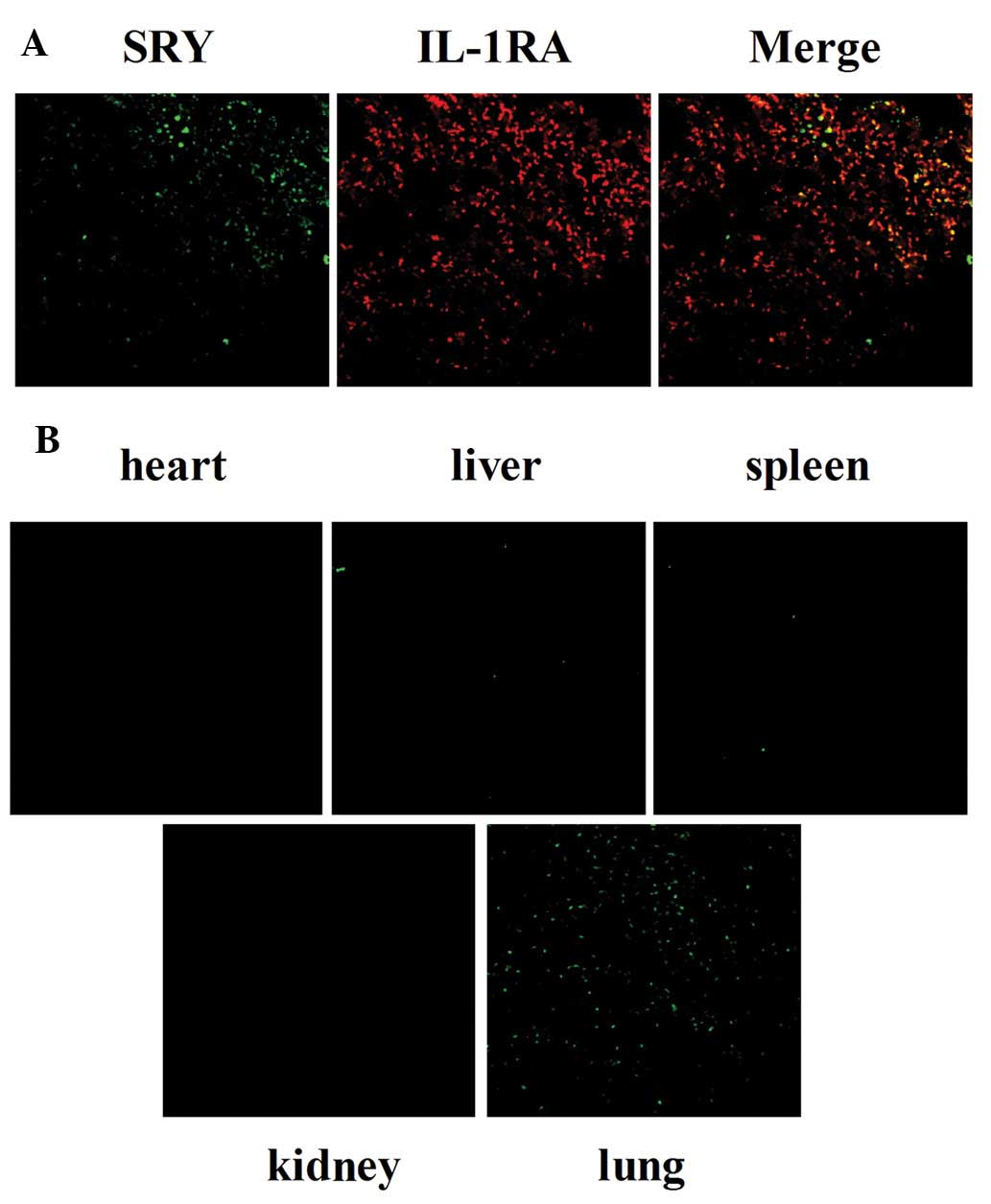|
1
|
Rimal B, Greenberg AK and Rom WN: Basic
pathogenetic mechanisms in silicosis: current understanding. Curr
Opin Pulm Med. 11:169–173. 2005. View Article : Google Scholar : PubMed/NCBI
|
|
2
|
Herzog EL, Chai L and Krause DS:
Plasticity of marrow-derived stem cells. Blood. 102:3483–3493.
2003. View Article : Google Scholar : PubMed/NCBI
|
|
3
|
Nishida H, Nakayama M, Tanaka H, et al:
Safety of autologous bone marrow stromal cell transplantation in
dogs with acute spinal cord injury. Vet Surg. 41:437–442. 2012.
View Article : Google Scholar : PubMed/NCBI
|
|
4
|
Osanai T, Kuroda S, Sugiyama T, et al:
Therapeutic effects of intra-arterial delivery of bone marrow
stromal cells in traumatic brain injury of rats - in vivo cell
tracking study by near-infrared fluorescence imaging. Neurosurgery.
70:435–444. 2012. View Article : Google Scholar
|
|
5
|
Zhao L, Feng Z, Hu B, Chi X and Jiao S: Ex
vivo-expanded bone marrow mesenchymal stem cells facilitate
recovery from chemically induced acute liver damage.
Hepatogastroenterology. 59:2389–2394. 2012.PubMed/NCBI
|
|
6
|
Islam MN, Das SR, Emin MT, et al:
Mitochondrial transfer from bone-marrow-derived stromal cells to
pulmonary alveoli protects against acute lung injury. Nat Med.
18:759–765. 2012. View
Article : Google Scholar : PubMed/NCBI
|
|
7
|
Luan Y, Zhang X, Kong F, Cheng GH, Qi TG
and Zhang ZH: Mesenchymal stem cell prevention of vascular
remodeling in high flow-induced pulmonary hypertension through a
paracrine mechanism. Int Immunopharmacol. 14:432–437. 2012.
View Article : Google Scholar : PubMed/NCBI
|
|
8
|
Aslam M, Baveja R, Liang OD, et al: Bone
marrow stromal cells attenuate lung injury in a murine model of
neonatal chronic lung disease. Am J Respir Crit Care Med.
180:1122–1130. 2009. View Article : Google Scholar : PubMed/NCBI
|
|
9
|
Ortiz LA, Gambelli F, McBride C, et al:
Mesenchymal stem cell engraftment in lung is enhanced in response
to bleomycin exposure and ameliorates its fibrotic effects. Proc
Natl Acad Sci USA. 100:8407–8411. 2003. View Article : Google Scholar : PubMed/NCBI
|
|
10
|
Luan Y, Zhang ZH, Wei DE, et al:
Implantation of mesenchymal stem cells improves right ventricular
impairments caused by experimental pulmonary hypertension. Am J Med
Sci. 343:402–406. 2012. View Article : Google Scholar : PubMed/NCBI
|
|
11
|
Rojas M, Xu J, Woods CR, et al: Bone
marrow-derived mesenchymal stem cells in repair of the injured
lung. Am J Respir Cell Mol Biol. 33:145–152. 2005. View Article : Google Scholar : PubMed/NCBI
|
|
12
|
Nemeth K, Keane-Myers A, Brown JM, et al:
Bone marrow stromal cells use TGF-beta to suppress allergic
responses in a mouse model of ragweed-induced asthma. Proc Natl
Acad Sci USA. 107:5652–5657. 2010. View Article : Google Scholar : PubMed/NCBI
|
|
13
|
Wang PP, Xie DY, Liang XJ, et al: HGF and
direct mesenchymal stem cells contact synergize to inhibit hepatic
stellate cells activation through TLR4/NF-kB pathway. PLoS One.
7:e434082012. View Article : Google Scholar : PubMed/NCBI
|
|
14
|
Jin P, Zhang X, Wu Y, et al:
Streptozotocin-induced diabetic rat-derived bone marrow mesenchymal
stem cells have impaired abilities in proliferation, paracrine,
antiapoptosis, and myogenic differentiation. Transplant Proc.
42:2745–2752. 2010. View Article : Google Scholar
|
|
15
|
Xu M, Uemura R, Dai Y, Wang Y, Pasha Z and
Ashraf M: In vitro and in vivo effects of bone marrow stem cells on
cardiac structure and function. J Mol Cell Cardiol. 42:441–448.
2007. View Article : Google Scholar : PubMed/NCBI
|
|
16
|
Mezey E: The therapeutic potential of bone
marrow-derived stromal cells. J Cell Biochem. 112:2683–2687. 2011.
View Article : Google Scholar : PubMed/NCBI
|
|
17
|
Reis LA, Borges FT, Simões MJ, Borges AA,
Sinigaglia-Coimbra R and Schor N: Bone marrow-derived mesenchymal
stem cells repaired but did not prevent gentamicin-induced acute
kidney injury through paracrine effects in rats. PLoS One.
7:e440922012. View Article : Google Scholar
|
|
18
|
Bakondi B, Shimada IS, Perry A, et al:
CD133 identifies a human bone marrow stem/progenitor cell
sub-population with a repertoire of secreted factors that protect
against stroke. Mol Ther. 17:1938–1947. 2009. View Article : Google Scholar : PubMed/NCBI
|
|
19
|
Burdon TJ, Paul A, Noiseux N, Prakash S
and Shum-Tim D: Bone marrow stem cell derived paracrine factors for
regenerative medicine: current perspectives and therapeutic
potential. Bone Marrow Res. 2011:Dec 6–2010.(Epub ahead of
print).
|
|
20
|
Arend WP: Interleukin 1 receptor
antagonist. A new member of the interleukin 1 family. J Clin
Invest. 88:1445–1451. 1991. View Article : Google Scholar : PubMed/NCBI
|
|
21
|
Ortiz LA, Dutreil M, Fattman C, et al:
Interleukin 1 receptor antagonist mediates the antiinflammatory and
antifibrotic effect of mesenchymal stem cells during lung injury.
Proc Natl Acad Sci USA. 104:11002–11007. 2007. View Article : Google Scholar : PubMed/NCBI
|
|
22
|
Smajilagić A, Aljičević M, Redžić A,
Filipović S and Lagumdžija A: Rat bone marrow stem cells isolation
and culture as a bone formative experimental system. Bosn J Basic
Med Sci. 13:27–30. 2013.PubMed/NCBI
|
|
23
|
Abkowitz JL, Robinson AE, Kale S, Long MW
and Chen J: Mobilization of hematopoietic stem cells during
homeostasis and after cytokine exposure. Blood. 102:1249–1253.
2003. View Article : Google Scholar : PubMed/NCBI
|
|
24
|
Kinnaird T, Stabile E, Burnett MS, et al:
Local delivery of marrow-derived stromal cells augments collateral
perfusion through paracrine mechanisms. Circulation. 109:1543–1549.
2004. View Article : Google Scholar : PubMed/NCBI
|
|
25
|
Nagaya N, Kangawa K, Itoh T, et al:
Transplantation of mesenchymal stem cells improves cardiac function
in a rat model of dilated cardiomyopathy. Circulation.
112:1128–1135. 2005. View Article : Google Scholar : PubMed/NCBI
|
|
26
|
Sharma RI and Snedeker JG: Paracrine
interactions between mesenchymal stem cells affect substrate driven
differentiation toward tendon and bone phenotypes. PLoS One.
7:e315042012. View Article : Google Scholar
|
|
27
|
Krasnodembskaya A, Song Y, Fang X, et al:
Antibacterial effect of human mesenchymal stem cells is mediated in
part from secretion of the antimicrobial peptide LL-37. Stem Cells.
28:2229–2238. 2010. View
Article : Google Scholar : PubMed/NCBI
|
|
28
|
Zhang K and Phan SH: Cytokines and
pulmonary fibrosis. Biol Signals. 5:232–239. 1996. View Article : Google Scholar
|
|
29
|
Kolb M, Margetts PJ, Anthony DC, Pitossi F
and Gauldie J: Transient expression of IL-1beta induces acute lung
injury and chronic repair leading to pulmonary fibrosis. J Clin
Invest. 107:1529–1536. 2001. View
Article : Google Scholar : PubMed/NCBI
|
|
30
|
Zhang Y, Lee TC, Guillemin B, Yu MC and
Rom WN: Enhanced IL-1 beta and tumor necrosis factor-alpha release
and messenger RNA expression in macrophages from idiopathic
pulmonary fibrosis or after asbestos exposure. J Immunol.
150:4188–4196. 1993.PubMed/NCBI
|
|
31
|
Piguet PF, Vesin C, Grau GE and Thompson
RC: Interleukin 1 receptor antagonist (IL-1ra) prevents or cures
pulmonary fibrosis elicited in mice by bleomycin or silica.
Cytokine. 5:57–61. 1993. View Article : Google Scholar : PubMed/NCBI
|












